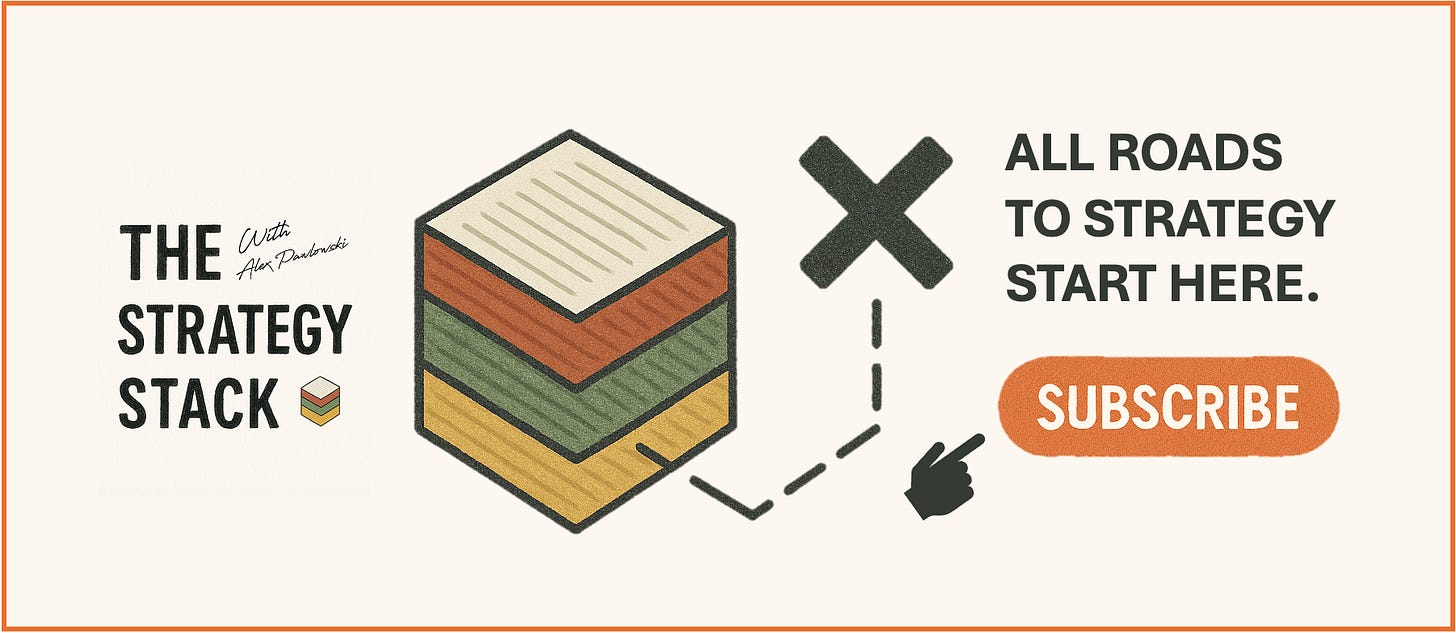Algorithmic Marginal Utility: Why AI Makes Everything Cheaper and Less Fun
#5: What is Algorithmic Marginal Utility? (5 minutes)
It’s 2025, and we live in a world where artificial intelligence has optimised nearly everything. Music, movies, dating, workouts, grocery shopping, therapy—if there’s a process, an algorithm is working behind the scenes to make it faster, cheaper and more efficient. This is the promise—and the peril—of digital transformation: a world designed by algorithms and optimized for efficiency.
And yet, somehow, life feels… flatter. Where’s the thrill? The magic? The messy serendipity that used to make things worth doing?
We’ve entered what I call the era of Algorithmic Marginal Utility—a world where every aspect of our experience is so optimised that the difference between good and great has become vanishingly small. It’s like music on shuffle forever: no skips, but also no bangers that hit you in the chest. Our collective AI strategy has been to optimise the present moment without asking what that does to meaning over time.
What is Algorithmic Marginal Utility?
In classical economics, marginal utility is the added satisfaction from consuming one more unit of a good or service. The more you have of something, the less you feel its impact.
Now apply that idea to your digital life. AI recommendation engines flood you with hyper‑relevant content: the next perfect video, the next perfect song, the next perfect snack. You’re always just “one more scroll” away from another dopamine hit. In the logic of digital transformation, this looks like success.
But over time, you stop feeling anything at all.
That’s because AI doesn’t care about emotional arcs or delayed gratification—it optimises for now. It’s good at reducing pain but terrible at creating meaning. A mature AI strategy has to recognise this trade‑off: you can’t automate wonder.
AI and the tyranny of optimisation
Think about Spotify in 2025. You open the app and it knows your mood, time of day and even your recent search history. It delivers you a perfectly personalised playlist—a vibe cocktail, powered by Spotify’s own AI‑driven personalisation research. It’s pleasant. It’s chill. It’s… forgettable. This is optimisation as AI strategy, pursued to its logical extreme.
Now contrast that with the feeling of discovering a mixtape your crush made in high school—chaos, awkward transitions, weird track choices. But real. Personal. Emotional. AI is making everything smooth. In doing so, it’s sanding off the edges where meaning used to live.
The same goes for:
Netflix: You don’t choose movies anymore—the algorithm autoplays something you’ll probably like.
Amazon: You buy what’s suggested before you even realise you needed it.
Dating apps: Your matches are statistically optimised for you… yet first dates feel more like job interviews than sparks flying.
A narrowly defined digital transformation can strip away the friction and unpredictability that make us human.
Behavioural economics: the ‘why’ behind the flatness
AI’s effect on human experience is best understood through the lens of behavioural economics:
Hedonic adaptation. The more you consume pleasure, the less intense your reaction. AI serves you an endless buffet of mid‑tier joy.
Paradox of choice. While AI narrows your options to reduce decision fatigue, it also robs you of exploration and ownership.
Satisficing vs. maximising. AI assumes we want to find “good enough” fast. But humans often enjoy the search, the frustration, the learning curve.
We’re built for narrative, not efficiency. Any AI strategy that forgets this will produce a world of comfortable boredom.
Culture in the age of algorithms
What’s happening to culture when everything is data‑driven?
Music. Genres blur into algorithm‑friendly homogeneity. Playlists optimised for productivity, focus or sleep—not passion, rebellion or heartbreak.
Film & TV. AI‑generated scripts are now a real thing. Formulaic plots tested for audience retention. Zero risks, zero soul.
Fashion. Microtrends birthed by TikTok and killed by recommendation engines before they become actual movements.
We’re seeing the death of the subculture. Anything interesting gets surfaced, monetised and flattened in record time. And with generative AI tools like Midjourney and Sora now in everyone’s hands, anyone can make anything—but fewer people care to. Digital transformation needs a counterbalance: a re‑investment in craftsmanship, weirdness and divergence.
The feedback loop trap
AI optimises what works. It studies what you like based on what you previously liked. So if you liked indie music last year, it’ll keep you on a slow drip of adjacent content. It won’t introduce you to Mongolian throat singing or 1980s Japanese city pop unless you ask—and even then, it’s probably a sanitised version of it. This is the trap of comfort.
Over time, your world narrows. The peaks and valleys flatten. Your curiosity atrophies. And the systems interpret that as success. A more humane AI strategy must break this loop.
Spotify vs. the live scene: a real‑world case
Take the ongoing debate in 2025 about live music vs. streaming. While Spotify continues to dominate audio consumption, we’re seeing a counter‑movement: a resurgence in live shows, vinyl and “slow listening.” Fans crave the rawness of a live set, the imperfection of a cracked voice or a missed note. That’s where memory lives. That’s where soul lives.
Artists, too, are fighting back. Björk has been experimenting with deliberately ‘unstreamable’ tracks—experimental, non‑optimised and long‑form—as a rebellion against algorithmic aesthetics. In an age of digital transformation, these choices remind us that meaning often emerges from inefficiency.
What we can do about it
We’re not anti‑AI. This isn’t a luddite rant. But we need:
Intentional friction. Spaces that don’t track you, don’t recommend, don’t autocomplete.
Human‑first curation. Bring back tastemakers—DJs, critics, weird friends.
Savour over speed. Value the time it takes to love something. Make effort part of the experience.
Build for awe, not just ease. Tech should make life better, not just more convenient.
A sophisticated AI strategy isn’t about rejecting tools; it’s about designing systems that preserve discovery, surprise and emotional range even as digital transformation advances.
Final perspective: are we optimising ourselves out of being human?
In the quest to make everything smoother, we may be sanding down our humanity. We are creatures of chaos, longing, mystery, contradiction. AI, in its current form, is none of those things. It offers consistency, not catharsis. Prediction, not surprise. Satisfaction, not joy.
The challenge of our generation won’t be whether AI takes our jobs. It will be whether we let it take our wonder. A humane AI strategy will accept that friction and messiness are not inefficiencies to be eliminated but integral parts of life. As we pursue digital transformation, we have to decide which edges are worth keeping jagged.
Hit subscribe to get it in your inbox. And if this spoke to you:
➡️ Forward this to a strategy peer who’s feeling the same shift. We’re building a smarter, tech-equipped strategy community—one layer at a time.
About: Alex Michael Pawlowski is an advisor, investor and author who writes about topics around technology and international business.
For contact, collaboration or business inquiries please get in touch via lxpwsk1@gmail.com.
Source:
[1] Ahmad, Z. F., Lelis, L. H. S., & Bowling, M. (2020). Marginal Utility for Planning in Continuous or Large Discrete Action Spaces. Proceedings of the 34th Conference on Neural Information Processing Systems (NeurIPS 2020).
[2] Khan Academy. (n.d.). Total utility and marginal utility. Retrieved from https://www.khanacademy.org/economics-finance-domain/microeconomics/choices-opp-cost-tutorial/marginal-utility-tutorial/a/lesson-overview-total-utility-marginal-utility-and-utility-maximization
[3] The Motley Fool. (2025). What is Marginal Utility? Overview and Examples. Retrieved from https://www.fool.com/terms/m/marginal-utility/
[4] FasterCapital. (2025). Marginal utility: The Theory of Price and Maximizing Customer Satisfaction. Retrieved from https://fastercapital.com/content/Marginal-utility--The-Theory-of-Price-and-Maximizing-Customer-Satisfaction.html
[5] ResearchGate. (2020). Diminishing Marginal Utility of Wealth. Retrieved from https://www.researchgate.net/figure/Diminishing-Marginal-Utility-of-Wealth_fig1_339173853
[6] SlideTeam. (n.d.). Marginal Utility Curve PowerPoint Template Slide. Retrieved from https://www.slideteam.net/marginal-utility-curve-powerpoint-template-slide.html
[7] Simplus. (n.d.). Infographic: AI + Energy/Utilities. Retrieved from https://www.simplus.com/infographic-ai-energy-utilities/
[8] Smart Energy Consumer Collaborative. (2024). Computing Consumer Interest in AI Infographic. Retrieved from https://smartenergycc.org/computing-consumer-interest-in-ai-infographic/






